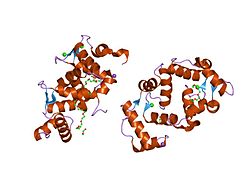Top Qs
Timeline
Chat
Perspective
Neuronal calcium sensor-1
Neuronal calcium sensory protein From Wikipedia, the free encyclopedia
Remove ads
Neuronal calcium sensor-1 (NCS-1) also known as frequenin homolog (Drosophila) (freq) is a protein that is encoded by the FREQ gene in humans.[5] NCS-1 is a member of the neuronal calcium sensor family,[6] a class of EF hand containing calcium-myristoyl-switch proteins.[7]
Remove ads
Function
Summarize
Perspective
NCS-1 regulates synaptic transmission,[8] helps control the dynamics of nerve terminal growth,[9][10][8] is critical for some forms of learning and memory in C. elegans[11] and mammals,[12] regulates corticohippocampal plasticity; and enhancing levels of NCS-1 in the mouse dentate gyrus increases spontaneous exploration of safe environments,[12] potentially linking NCS-1 to curiosity.[13]
NCS-1 is a calcium sensor, not a calcium buffer (chelator); thus it is a high-affinity, low-capacity, calcium-binding protein.
Frq can substitute for calmodulin in some situations. It is thought to be associated with neuronal secretory vesicles and regulate neurosecretion.
- It is the Ca2+-sensing subunit of the yeast phosphatidylinositol (PtdIns)-4-OH kinase, PIK1
- It binds to many proteins, some in calcium dependent and some in calcium independent ways, and switches many of the targets "on" (some off).
- Calcineurin (protein phosphatase 2B)
- GRK2 (G-protein-coupled receptor kinase 2)
- D2 dopamine receptor
- IL1RAPL1 (interleukin-1 receptor accessory protein-like 1 protein)
- PI4KIIIβ (type III phosphatidylinositol 4-kinase β)
- IP3 receptor (this activity is inhibited by lithium - a drug used for the treatment of bipolar disorder)[14]
- 3',5'-cyclic nucleotide phosphodiesterases
- ARF1 (ADP Ribosylation factor 1)
- A type (Kv4.3; Shal-related subfamily, member 3) voltage-gated potassium channels
- Nitric oxide synthase
- TRPC5 channel[15]
- Ric8a[16]
- Frq modulates Ca2+ entry through a functional interaction with the α1 voltage-gated Ca2+-channel subunit.[8]
Additionally, NCS-1 is redox-sensitive: under oxidizing conditions it forms a covalent disulfide-linked dimer via Cys38 (dNCS-1). Elevation of free Zn²⁺ (as during oxidative stress) specifically promotes this dimerization, whereas increasing intracellular Ca²⁺ does not. The dimer binds Ca²⁺ in only one EF-hand per monomer, displays reduced α-helicity and thermal stability with increased surface hydrophobicity, and shows ~20-fold higher affinity for GRK1 accompanied by stronger inhibition of the kinase. dNCS-1 can also coordinate Zn²⁺ and exhibits asymmetrical, more flexible subunits. In cells, dNCS-1 is reduced by the thioredoxin system; otherwise it accumulates in perinuclear puncta and aggregates targeted by the proteasome. Notably, NCS-1 silencing decreases susceptibility to oxidative-stress-induced apoptosis in Y79 cells, implicating NCS-1 in redox-regulated survival pathways.[17]
Remove ads
Structure
NCS-1 is a globular protein consisting of ten alpha-helices. Four pairs of alpha-helices each form independent 12-amino-acid loops containing a negatively charged calcium binding domain known as an EF-hand. However, only three of these EF hands are functional (the most N-terminal EF-hand does not bind calcium). They could be occupied not only by calcium but also by magnesium and zinc ions.[18] NCS-1 also contains at least two known protein binding domains, and a large surface exposed hydrophobic crevice containing EF-hands three and four. There is a myristoylation motif at the N-terminus that presumably allows NCS-1 to associate with lipid membranes.
Remove ads
Clinical significance
The expression of NCS-1 increases in bipolar disorder and some forms of schizophrenia[19] and decreases in inflammatory bowel disease.[20] A mutant of NCS-1, R102Q, has also been found in one patient with Autism.[21] In addition NCS-1 is significant in intelligence in creating curiosity by its function on dopamine D2 receptors in the dentate gyrus, increasing memory for complex tasks.[22] Interactions of lithium ions (Li+) with NCS-1 has also been linked as a possible treatment for protection against psychotic disorders.[23]
History
NCS-1 was originally discovered in Drosophila as a gain-of-function mutation associated with frequency-dependent increases in neurotransmission.[24] A role in neurotransmission was later confirmed in Drosophila using frq null mutants.[8] Work in bovine chromaffin cells demonstrated that NCS-1 is also a modulator of neurotransmission in mammals.[25] The designation 'NCS-1' came from the assumption that the protein was expressed only in neuronal cell types, which is not the case.[26]
Remove ads
References
Further reading
External links
Wikiwand - on
Seamless Wikipedia browsing. On steroids.
Remove ads





